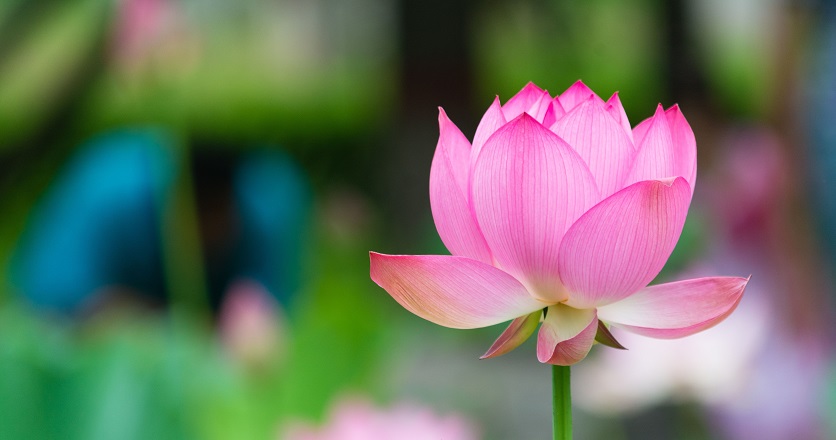Font Size
- Small
- Medium
- Large
Related Websites
How to Chant
How to Chant
How to chant Nam-myoho-renge-kyo, its meaning and the daily Buddhist practice of Soka Gakkai members.
See video script:
[Narrator]: Soka Gakkai members chant Nam-myoho-renge-kyo and recite excerpts from the Lotus Sutra in order to bring forth from within their lives the highest state of life known as Buddhahood. Buddhahood is characterized by abundant wisdom, courage and compassion and a sense of empowerment.
Soka Gakkai members strive to chant in the morning and evening facing the Gohonzon enshrined in an altar in their homes.
The Gohonzon is a scroll with Nam-myoho-renge-kyo written down the center.
[Speaker 1]: To begin chanting, if you haven’t already set up an altar, sit upright facing a blank wall or something that won’t distract you. You can sit on the floor or in a chair in whichever position is most comfortable for you.
[Speaker 2]: Put your hands together [places palms together] in front of you like this.
[Speaker 1]: Start by chanting Nam-myoho-renge-kyo on one note. Make sure to keep your eyes open.
There’s no need to visualize particular images or to empty your mind. Just be yourself and focus on your hopes and prayers and then simply concentrate on the sound of Nam-myoho-renge-kyo.
[Speaker 2]: When you first begin chanting even just a few minutes every day is great. Of course, at first, it may take a while to get used to the pronunciation, so you can start off slowly like this:
Nam-myoho-renge-kyo, Nam-myoho-renge-kyo, Nam-myoho-renge-kyo . . .
[Narrator]: The phrase Nam-myoho-renge-kyo means “I dedicate my life to the wonderful law of cause and effect” that leads to Buddhahood.
“Nam” means dedication and “myoho” means mystic or wonderful law—an expression of the dharma or underlying principle inherent in all life.
“Myo,” in particular signifies the unseen essence of life as well as its potential to revive and open while “ho” refers to life’s manifestations.
“Renge” means lotus flower. The lotus produces flowers and fruit at the same time and therefore symbolizes the simultaneity of cause and effect. Just as the pure lotus flower blooms in a muddy pond, our inherent Buddha nature comes to shine amidst the harsh realities of life.
“Kyo” is voice or teaching of the Buddha.
[Speaker 1]: Chanting Nam-myoho-renge-kyo is like a spiritual workout.
I always find it really refreshes and revitalizes me.
It’s almost like recharging my batteries.
When I’m chanting regularly I have more energy and the strength not to be defeated by my problems.
[Narrator]: The practice of chanting Nam-myoho-renge-kyo was established by a 13th-century Japanese priest named Nichiren in order to enable all people to tap into their inherent Buddha nature.
In addition to chanting Nam-myoho-renge-kyo, Soka Gakkai members recite parts of the 2nd and 16th chapters of the Lotus Sutra.
The 2nd chapter is entitled “Expedient Means” and the 16th is called “Life Span.”
Chanting Nam-myoho-renge-kyo and reciting these passages is known as “gongyo.”
Nichiren Daishonin stressed that these chapters best explain the essence of the Lotus Sutra and express Shakyamuni Buddha’s core message: that everyone, without exception, possesses the enlightened life state of Buddhahood.
[Speaker 2]: So that’s the basic practice—chanting Nam-myoho-renge-kyo and doing gongyo.
[Speaker 1]: But it’s difficult to maintain a consistent practice just on my own. Studying Buddhism and practicing with other people helps me deepen my understanding.
[Speaker 2]: Meeting all kinds of people who practice this Buddhism gives me new perspectives and prevents my practice from becoming self-centered.
[Speaker 1]: Hearing how other people have used their practice to challenge things they thought were impossible inspires me to make greater efforts in my life.
[Narrator]: A core activity of Soka Gakkai in many countries is the local discussion meeting where people can ask questions and engage in dialogue about the philosophy and practice of Nichiren Buddhism.
Soka Gakkai members strive to chant in the morning and evening facing the Gohonzon enshrined in an altar in their homes.
The Gohonzon is a scroll with Nam-myoho-renge-kyo written down the center.
[Speaker 1]: To begin chanting, if you haven’t already set up an altar, sit upright facing a blank wall or something that won’t distract you. You can sit on the floor or in a chair in whichever position is most comfortable for you.
[Speaker 2]: Put your hands together [places palms together] in front of you like this.
[Speaker 1]: Start by chanting Nam-myoho-renge-kyo on one note. Make sure to keep your eyes open.
There’s no need to visualize particular images or to empty your mind. Just be yourself and focus on your hopes and prayers and then simply concentrate on the sound of Nam-myoho-renge-kyo.
[Speaker 2]: When you first begin chanting even just a few minutes every day is great. Of course, at first, it may take a while to get used to the pronunciation, so you can start off slowly like this:
Nam-myoho-renge-kyo, Nam-myoho-renge-kyo, Nam-myoho-renge-kyo . . .
[Narrator]: The phrase Nam-myoho-renge-kyo means “I dedicate my life to the wonderful law of cause and effect” that leads to Buddhahood.
“Nam” means dedication and “myoho” means mystic or wonderful law—an expression of the dharma or underlying principle inherent in all life.
“Myo,” in particular signifies the unseen essence of life as well as its potential to revive and open while “ho” refers to life’s manifestations.
“Renge” means lotus flower. The lotus produces flowers and fruit at the same time and therefore symbolizes the simultaneity of cause and effect. Just as the pure lotus flower blooms in a muddy pond, our inherent Buddha nature comes to shine amidst the harsh realities of life.
“Kyo” is voice or teaching of the Buddha.
[Speaker 1]: Chanting Nam-myoho-renge-kyo is like a spiritual workout.
I always find it really refreshes and revitalizes me.
It’s almost like recharging my batteries.
When I’m chanting regularly I have more energy and the strength not to be defeated by my problems.
[Narrator]: The practice of chanting Nam-myoho-renge-kyo was established by a 13th-century Japanese priest named Nichiren in order to enable all people to tap into their inherent Buddha nature.
In addition to chanting Nam-myoho-renge-kyo, Soka Gakkai members recite parts of the 2nd and 16th chapters of the Lotus Sutra.
The 2nd chapter is entitled “Expedient Means” and the 16th is called “Life Span.”
Chanting Nam-myoho-renge-kyo and reciting these passages is known as “gongyo.”
Nichiren Daishonin stressed that these chapters best explain the essence of the Lotus Sutra and express Shakyamuni Buddha’s core message: that everyone, without exception, possesses the enlightened life state of Buddhahood.
[Speaker 2]: So that’s the basic practice—chanting Nam-myoho-renge-kyo and doing gongyo.
[Speaker 1]: But it’s difficult to maintain a consistent practice just on my own. Studying Buddhism and practicing with other people helps me deepen my understanding.
[Speaker 2]: Meeting all kinds of people who practice this Buddhism gives me new perspectives and prevents my practice from becoming self-centered.
[Speaker 1]: Hearing how other people have used their practice to challenge things they thought were impossible inspires me to make greater efforts in my life.
[Narrator]: A core activity of Soka Gakkai in many countries is the local discussion meeting where people can ask questions and engage in dialogue about the philosophy and practice of Nichiren Buddhism.
Discover more:
Nam-myoho-renge-kyo: A Pronunciation Guide
A karaoke-style guide showing the pronunciation and rhythm of chanting Nam-myoho-renge-kyo.
Explore more:
Gongyo: A Pronunciation Guide
A karaoke-style guide showing the pronunciation and rhythm of gongyo, the recitation of excerpts from the Lotus Sutra.
Learn more:







